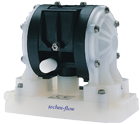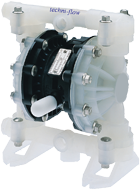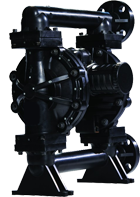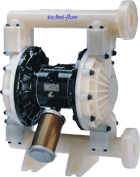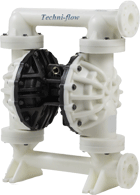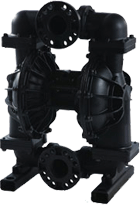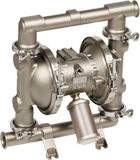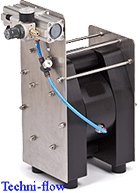Diaphragm air pumps
pumps@techni-flow-pumps.com
Techni-Flow diaphragm pumps are pumps that operate using pneumatic energy.
The advantages of this technology are numerous:
Safety: Pneumatic pumps operate without electricity, which reduces the risk of electrical accidents.
Reliability: Diaphragm pumps operate without rotating parts, the risk of leaks is reduced to a minimum.
Simplicity: Pneumatic pumps automatically adapt their rates according to the pressure.
Robustness: Diaphragm pumps can run dry and are self-priming.
Flow range: from 3l / mn to 900l / mn.
Pressure range from 0 to 16bar.
Viscosity range up to 15,000 cps.
Temperature range up to 100 ° C.
Diaphragm pumps TFG025
The TFG025 diaphragm pump range is the smallest in the range:
This diaphragm pump is a pump that can be easily integrated into a stationary or mobile machine. Thanks to its assisted flat valve design, it has the particularity of being able to be installed in any position.
Atex version available.
Flow rate up to 15l / min.
Pressure up to 7 bar.
Viscosity up to 300 cps
Diaphragm pumps TFG100
Diaphragm pumps for flow rates <55l / min: This pump is available in plastic or metal for pumping applications requiring a lightweight and compact diaphragm pump.
This pump is also used as a drum pump and allows total emptying of the drums. 200l drums.
Flow rate up to 30l/min.
Pressure up to 7 bar.
Viscosity up to 3000 cps
Diaphragm pumps TFG200
Diaphragm pump for flow rates up to 130l / min:
This diaphragm pump is the most powerful of the small transportable pumps, it is available in plastic and metal.
This pump size allows pumping of high viscosity fluid up to 7500cpo.
Flow rate up to 130l / min.
Pressure up to 8 bar.
Viscosity up to 7000 cps
Diaphragm pumps TFG400
Diaphragm pump for flow rates up to 378.5l / min:
The TFG400 diaphragm pump range is the first stationary pump, particularly intended for pumping high viscosity fluids up to 10,000CPO or fluids loaded with solid particles.
Flow rate up to 378l / min.
Pressure up to 8 bar.
Viscosity up to 10,000 cps
Diaphragm pumps TFG1500
The TFG 1500 range diaphragm pumps are the most powerful pumps in the range, the most demanding applications in flow are possible, their flow capacity reaching 1100l / min In addition, their robustness makes them advantageously suitable for all applications of pumping in difficult environments such as mining, for example.
Flow rate up to 900l / min.
Pressure up to 8 bar.
Viscosity up to 10,000 cps
Principle of operation of pneumatic diaphragm pumps
The pumps are mainly composed of 2 membranes linked by a mechanical axis, 4 ball valves and 4 seats and a pneumatic distributor responsible for distributing the air alternately from one membrane to another.
1st cycle:
the distributor sends the air into the left chamber, the left diaphragm pushes the fluid which presses the lower left ball onto its seat and lifts the upper one allowing the fluid to expel from the top.
The two membranes being linked, the membrane starts a reverse movement:
it creates a vacuum in the right chamber, which lifts the bottom right ball and sucks the fluid into the chamber.
2nd cycle:
when the first membrane reaches the end of its stroke the air distributor automatically switches and sends the air to the opposite chamber and repeats the same cycle.
The alternation creates a pulsating phenomenon which can be avoided with the use of an antipulsator.
The suction quality is essential for the correct functioning of the pneumatic pump:
it is necessary to respect the maximum size of the solid particles sucked, and to check the losses charged to the suction which must be lower than the recommendations of the vacuum pump.
membranes determined.
Pipe cleaning in the food industry
The flow rate requested by the user is 50l / min of soda, and 50l / min of nitric acids:
Solution retained: for the soda feed:
a TFG400 diaphragm pump with a polypropylene body and PTFE diaphragms.
This pump is capable of delivering a flow rate 378l/m, so it is largely dimensioned and allows for possible increases in production.
For nitric acid supply A TFG400PVTF pump with a PVDF body chemically compatible with nitric acid.
The size of the two pneumatic pumps has been intentionally oversized so as to be able to adapt to future production extensions planned by the customer, in the event of an increase in the demand for cleaning fluid for the cip, the pump will automatically supply the surplus of flow rate without operator intervention, which will prevent a possible change in the size of the diaphragm pump in the future.
Pneumatic diaphragm pump for heat treatment furnace fluid:
The heat treatments of parts are carried out in heat treatment furnaces generally under vacuum, the parts are heated at high temperature, and are immersed in a bath of particulate chemical fluids.
The chemical composition of the complex bath directly influences the chemical structure of the part to modify its mechanical characteristics.
Many types of mixture exist and their corrosivity is significant, especially with metals.
Heat treatment fluid baths should be kept clean to avoid quality problems.
The cleaning is ensured by a filtration carried out after each treatment of parts:
a pneumatic diaphragm pump sucks the fluid in order to inject it into techni-flow filters in order to remove impurities.
The material of the diaphragm pump is determined based on the chemical composition of the heat treatment bath.
Certain otherwise corrosive mixtures require pumps made entirely from machined PTFE.
In most cases a polypropylene diaphragm pump body is sufficient.
Pneumatic slaughterhouse pump
In slaughterhouses after slaughter of animals the blood must be collected for use as food, or for disposal as waste.
For these two applications, pneumatic diaphragm pumps are used, but of different qualities.
The pump for treating blood as waste is a standard industrial grade stainless steel diaphragm pump.
The blood is collected in underground tanks and contains many solid particles in suspension.
The pneumatic pump must be sized to be able to absorb these particles without blocking, generally for these applications a 3 ”pump is used.
Pneumatic pump for descaling and sludge removal
In the industrial sector, descaling is carried out by maintenance companies, the applications are multiple and require pumps with a wide range of use, whether in flow rate but also in pressure.
The descaling and sludge removal fluids are multiple and depend on the nature of the piping and the construction material of the descaling device. Mainly based on phosphoric acid, hydrochloric acid or in some cases citric acid. The principle of operation is simple:
the cleaning solution is circulated throughout the loop circuit.
For this application, the use of a pneumatic diaphragm pump is used, the flow rate will automatically adapt to the evolution and degree of obstruction of the pipes.
At the start of the cycle the flow rate will be minimum and the maximum pressure, and at the end of the cycle the pressure will be reduced and the maximum flow rate
Diaphragm pump in mail envelope manufacture: :
In the envelope manufacturing process, a machine is used to distribute the glue intended for closing the envelope:
this machine consists of two rollers in which a pump sends a quantity of glue, the surplus of which must be recovered in a container located below.
For this application, we used a pneumatic polypropylene diaphragm pump compatible with the chemical composition of the glue, this diaphragm pump will be equipped with a double inlet double outlet kit so as to divide the flow into two separate networks of the same flow.
The first network is used to fill the rollers, the second to recover the excess glue collected in the lower tray.
This technique has the advantage of using a single pneumatic diaphragm pump instead of two, which simplifies installation
Diaphragm pump for filter planted with reeds
In the dairy industry, cheese factory or milking parlor, the so-called white water waste consists mainly of whey and cheese particles.
This effluent is corrosive with a ph of 3 to 5, and polluting and therefore cannot be discharged into the network as it is.
In these applications, a pneumatic membrane pump can be used to spray and distribute the whey on a plant filter on a bed of reeds (phyto-purification).
The diaphragm pump made of a polypropylene body resists the acidity of the whey very well, and the easily adjustable flow rate avoids overly complicated processes.
Membrane pump to feed ink rollers or glue rollers
In the printing industries the production machines must feed the ink or glue application nozzles with great regularity, the productions being more and more flexible, it is imperative that this ink supply regularity be complied with, regardless of variations in the speed of the printing machine.
For this, an ink storage bin is made as close as possible to the printing nozzles.
The level of this tank is constant and fed in proportion to the rate by one or more diaphragm pump, the piloting of which is pneumatic.
If the ink reaches the low level, a level detector gives information to the pneumatic pressure regulator which accelerates the rate of the pneumatic pump until the high level is reached the Allore pump will run at idle speed which will produce a flexible level regulation while achieving constant stirring of the ink.
Pneumatic condensate pump for supplying an industrial analyzer
A power generation facility control company wants to power a condensate water analyzer.
This water is polluted with various corrosive chemical compounds, in addition the operating area is atex. For this application, the pump having to operate continuously and having to adapt its flow rate to that of the analyzer, we chose a TFG100STF pneumatic diaphragm pump with the stainless steel body and the PTFE membranes.
pneumatic pumps for road bitumen emulsions
A manufacturer of road bitumen emulsions uses a large number of chemicals, mainly:
hydrochloric acid, and for some specific applications acetic acid and phosphoric acid.
the amount of these acids incorporated depend on the characteristics of the bituminous emulsion and the asphalt that is to be obtained.
The injected flow is controlled by an automatic device which supplies one or more pneumatic valves to the air supply to the pump.
Depending on the valve, actuating the pneumatic pump will work more or less quickly.
For pumping hydrochloric acid, a polypropylene pump body is selected for its good chemical resistance.
Lime milks pump for sweets.
The production process of industrial sugar made from sugar cane or beets, for example, uses lime milk:
Lime is produced in lime kilns.
Lime milk is made with the addition of more or less water to the lime depending on the concentration you want to obtain.
Lime milk depending on its concentration can be more or less viscous and abrasive.
In the production of sugar lime milk is added to the first juice which includes many impurities.
Milk of lime acts as a flocculant, so non-sugar particles can be separated more easily.
Lime milk also works to neutralize the juice.
The lime milk pump we mainly offer is a pneumatic diaphragm pump with a stainless steel body to resist heavy abrasion from lime milk.
Washing of gases and combustion fumes with lime milk
Many industries produce polluting combustion fumes, these gauze and smoke cannot be released into the atmosphere as they are.
It is advisable to wash, these to treat them so that the pollution produced is minimum.
To carry out the purification of the combustion gases, one proceeds in several stages, the first of which is to spray lime milk on the combustion gases directly at the outlet of the furnace or boiler.
Lime ensures the neutralization of chlorinated acids is sulfur.
The rate of the pump will be proportional to the flow rates to obtain a constant spray pressure of the milk of lime.
Pneumatic diaphragm pumps are often used for these operations because their flow rate adapts easily and automatically to variations in the operating rate of the flue gas and flue gas cleaning system.
Kaolin slurry pump for paper bleaching.
Kaolin or white clay is a mineral which is exploited for its whiteness in many industries such as stationery, ceramics etc.
In the process of making paper, kaolin slurry is widely used, the viscosity of the slurry is usually between 100 and 200 cps.
This material resembles slip which is used in the ceramic industries.
For this application we use a pneumatic diaphragm pump with an aluminum body.
Amine pump: purification of biogas.
Amines are organic solvents which are used to remove components polluting biomethanes so as to make them compatible with standard energy installations.
This is purification by chemical absorption.
The pneumatic pump must be compatible with several types of amines and must be used to fill the absorption column.
The amines are stored in 1000l mobile drums.
For this amine pumping application for biogas purification, a diaphragm pump with the elements in contact with the fluid in stainless steel and a PTFE membrane will be selected.
Pump for tartaric acid:
Tartaric acid is naturally present in many fruits, it is evidenced in certain forms such as for example the deposit that is observed at the bottom of wine barrels and less and less in wine bottles.
This deposit has no taste impact, but the current consumer does not admit it in a bottle.
This powder has many uses in food and cosmetics as well as in industry.
the engineering industry uses this natural material as a metal polishing pad, for example.
Cosmetic laboratories also use tartaric acid for the preparation of toothpastes.
To pump this raw material, you absolutely need a pump that is resistant to chemical corrosion, but also a pump that is resistant to abrasion. For industrial applications, we will offer a pneumatic pump with a standard stainless steel body and seats, for cosmetic or food applications, a pneumatic pump with sanitary approval is required. Spirulina filtration
Pneumatic pump for spirulina.
The production of spirulina involves several phases:
pumping the spirulina float on the surface of the culture baths:
a pneumatic membrane pump sucks in a floating skimmer:
the pump will gently pump a mixture of water and spirulina.
This spirulina mixed with water is transferred to a filtration tank.
Spirulina filtration
The spirulina is placed on a filtration sieve, the filtration is done by gravity, but to improve the process, a pneumatic pump is added under the spirulina filtration cloth which pumps the filtration water and increases the vacuum under the filter, which improves the filtration speed and increases the quantity of water extracted from the spirulina.
Agricultural tire ballasting:
Diaphragm pumps can be used as tire ballast pumps.
The method involves filling part of the tractor tires with a mixture of water and antifreeze so as to weigh down the bottom of the tractor, which improves traction.
With the tractor tire nearly inflated, the diaphragm pump begins filling with an existing back pressure.
Pumps for printing machines cleaning
Printing machines in industrial printing houses are used intensively and must always be functional.
Unfortunately, the normal operation of these machines and generators of a regular fouling due to the use of consumables such as varnish inks which dry up eventually fouling the printing machine.
To ensure continuous cleaning, a powerful cleaning mixture based on different chemical fluids such as alcohols and solvents is used.
To ensure the pumping of these fluids and their delivery to all points cleaned atex acetal diaphragm pumps are used.
For pumps, alcohols and solvents, for degreasers a pneumatic polypropylene pump and sufficient.
Site Pump:
A motorway site has a problem with flooding its site due to water infiltration from a river.
The evacuated water flow rate is approximately 500l / min, the water is muddy and contains numerous gravel of varying sizes.
Water infiltration which rarely occurs, the pump must be able to be stored for long periods and start at the first request.
For this pumping application, we chose a TFG1500 pneumatic diaphragm pump equipped with a worksite pump capable of pumping gravel of more than 10 mm.
This pump will be fitted with membranes with an 8 profile suitable for pumping abrasive fluids.
In this case of application, this diaphragm pump has the advantage of being able to be stored for long periods without deterioration:
There is no rotating joint, no mechanical seal which could become erased. The pump is blocked on start-up.
Paint productions pumps:
A paint production plant for the construction industry plans to build a new paint production line with a production capacity of 600l / min in the atex zone.
The solution adopted is the use of an ATEX TFG1500 diaphragm pump with 3 "connection which has a pumping capacity of 1100l / min.
Leachate pumping:
Leachate is a residual fluid that is formed by a flow of water or fluid through different substances.
The main name is for the residual liquid from domestic or industrial landfills.
The peculiarity of these fluids results from the large number of substances which compose them and from the variable aspect of this one according to many parameters.
The request comes from an industrial-type waste dump.
In the event of an incident there may be too much leachate production which must be removed quickly for treatment.
For this particular application, the largest plastic diaphragm pump in the range was selected.
The TFG1500PTF model with a polypropylene body and PTFE membranes.
In an emergency the diaphragm pump is able to prime dry without damage and at high speed to provide a very large flow.
As a result, the pump is able to empty the leachate to the end, at the end of pumping the pump sucks air and completely empties the pipes to avoid pollution when removing the hoses.
Diaphragm pump for skydrol
Skydrol is the name of the fluid commonly used to match the NSA307110 standard.
It is a liquid used as a hydraulic fluid in the aviation industry mainly because of its high flash point.
for pumping shydrol we use diaphragm pumps whose materials in contact with skydrol have been validated by the skydrol manufacturers.
For example aluminum and ptfe.
